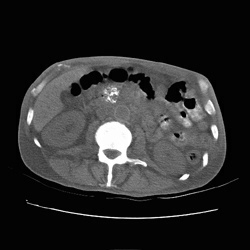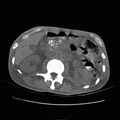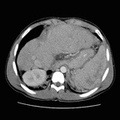
RADIOLOGY: PANCREAS: Case# 74: CALCIFIC PANCREATITIS. Forty-nine year old male with history of alcohol abuse, chronic renal insufficiency, and insulin-dependent diabetes mellitus with recent weight loss. The liver and spleen are normal in size and are unremarkable. The gallbladder is small and contracted. The pancreas is heavily calcified with pancreatic duct dilatation to 1.8 cm. The common bile duct is seen in the pancreatic head and is at the upper limits of normal. Chronic pancreatitis is now believed by many not to be merely the sequelae of repeated bouts of acute pancreatitis, but rather a separate disease entity with its own natural history. Chronic pancreatitis is usually due to related to long-term alcohol abuse. Other etiologies include hyperlipidemia, hyperparathyroidism, cholelithiasis and cystic fibrosis. In addition, a form of autosomal dominant familial pancreatitis known as hereditary pancreatitis can result in chronic calcific pancreatitis. CT findings in chronic pancreatitis include main pancreatic duct dilatation (66%), parenchymal atrophy (54%), calcifications (50%), pseudocysts (34%), focal gland enlargement (32%), biliary ductal dilatation (29%), and pancreatic fat/fascia abnormalities (16%). The pancreas may appear normal in 7% of cases. Irregular pancreatic duct dilatation with a duct width to total gland width ratio of less than 0.5 favors chronic pancreatitis. Smooth or beaded pancreatic ductal dilatation is associated with carcinoma.
- Author
- Peter Anderson
- Posted on
- Thursday 1 August 2013
- Tags
- cystic fibrosis, pancreas, radiology
- Albums
- Visits
- 2605


0 comments